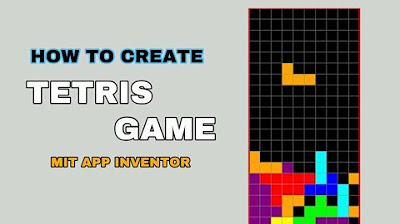MAZE GAME - PART 2| ANDROID APP DEVELOPMENT | MIT APP INVENTOR
Summary
TLDRThis tutorial guides users through the process of creating a maze game in MIT App Inventor. It covers designing the maze, adjusting it for various screen resolutions, and programming the ball's movement based on the accelerometer sensor. The game includes collision detection with walls and the hoop, determining win conditions, and managing user interactions. The video also explains how to program game reset behavior and transition between screens, offering a full walkthrough from start to finish for building an engaging and interactive mobile maze game.
Takeaways
- 😀 The script explains how to set up a maze game using MIT App Inventor, focusing on positioning components based on screen percentages.
- 😀 A procedure called 'setup maze' is created to organize instructions for setting up the game layout, including walls and obstacles.
- 😀 Horizontal and vertical walls are positioned using percentage values of the canvas width and height for dynamic resolution handling.
- 😀 The hoop image's position is adjusted by subtracting 70% of the screen's width and height, ensuring it stays in the remaining space.
- 😀 The accelerometer sensor is enabled to allow device tilt control, moving the ball based on the tilt of the phone or tablet.
- 😀 Ball movement is controlled with a formula that uses accelerometer x, y, and z values to adjust the ball's position on the screen.
- 😀 Collision detection is programmed to check if the ball touches the hoop (success) or any obstacle (failure), triggering different actions.
- 😀 When the ball touches the hoop, a pop-up is displayed with options to continue or quit, and the game state is updated accordingly.
- 😀 If the ball hits an obstacle, it resets to the starting position, and the game continues until the player succeeds.
- 😀 The game progresses to a new screen (level 2) if the player chooses to continue, with the accelerometer sensor re-enabled for the new level.
Q & A
What is the purpose of the 'setup maze' procedure?
-The 'setup maze' procedure is used to initialize the positions and sizes of the maze components, such as walls, the black square, and the hoop, based on the screen's resolution and percentage values.
How are the positions of the horizontal walls determined in the maze?
-The X and Y positions of the horizontal walls are set using percentage values of the canvas width and height. For example, the X position of the horizontal wall is set to 20% of the canvas width, and the Y position is fixed at 0, the topmost part.
Why is multiplication used when setting up the positions and sizes of components?
-Multiplication is used to calculate the relative positions and sizes of components based on percentages of the total canvas width and height. This ensures that the maze adapts correctly to different screen resolutions.
What is the significance of the accelerometer sensor in the game?
-The accelerometer sensor is used to detect the tilt of the device, which controls the ball's movement in the maze. This allows for interactive gameplay based on how the user tilts the device.
How does the game determine when the ball collides with the hoop or an obstacle?
-The game uses collision detection to check if the ball collides with the hoop or any obstacles. If the ball touches the hoop, the game ends, and a win message is displayed. If the ball touches an obstacle, it resets to the starting position.
What happens when the ball collides with the hoop?
-When the ball collides with the hoop, the accelerometer sensor is disabled, a win message is shown through a notifier component, and the hoop image is hidden while the 'You did it' image is made visible.
How does the user interact with the game after the ball falls into the hoop?
-After the ball falls into the hoop, the user is presented with a notifier asking if they want to continue or quit the game. Depending on the user’s choice, the game either restarts or moves to the next level.
What happens when the ball touches an obstacle in the maze?
-When the ball touches an obstacle, the game resets the ball’s position to the starting point, allowing the player to try again.
How are the X and Y positions of the hoop image set?
-The X and Y positions of the hoop image are calculated using subtraction from the total canvas width and height. This places the hoop in the remaining 30% of the screen after subtracting 70% from the total width and height.
What is the role of the 'Notifier' component in the game?
-The Notifier component is used to display messages to the user, such as a win message or an option to continue or quit the game. It allows for interactive decision-making during gameplay.
Outlines

This section is available to paid users only. Please upgrade to access this part.
Upgrade NowMindmap

This section is available to paid users only. Please upgrade to access this part.
Upgrade NowKeywords

This section is available to paid users only. Please upgrade to access this part.
Upgrade NowHighlights

This section is available to paid users only. Please upgrade to access this part.
Upgrade NowTranscripts

This section is available to paid users only. Please upgrade to access this part.
Upgrade NowBrowse More Related Video

Cara membuat aplikasi sederhana di MIT App Inventor

Tutorial Cepat Membuat Aplikasi Translator, menggunakan MIT App Inventor.

How to Make a Simple and Very Easy Tic Tac Toe Game in Mit App Inventor

Create a Math Quiz App in MIT App Inventor 2 || Quiz Mobile App || MIT App Inventor Educational App

Part1 Maze Runner: Pengenalan dan Persiapan Gim

Cara Membuat Tetris sederhana untuk pemula di Mit App inventor GRATIS 2024 | programmer pemula
5.0 / 5 (0 votes)